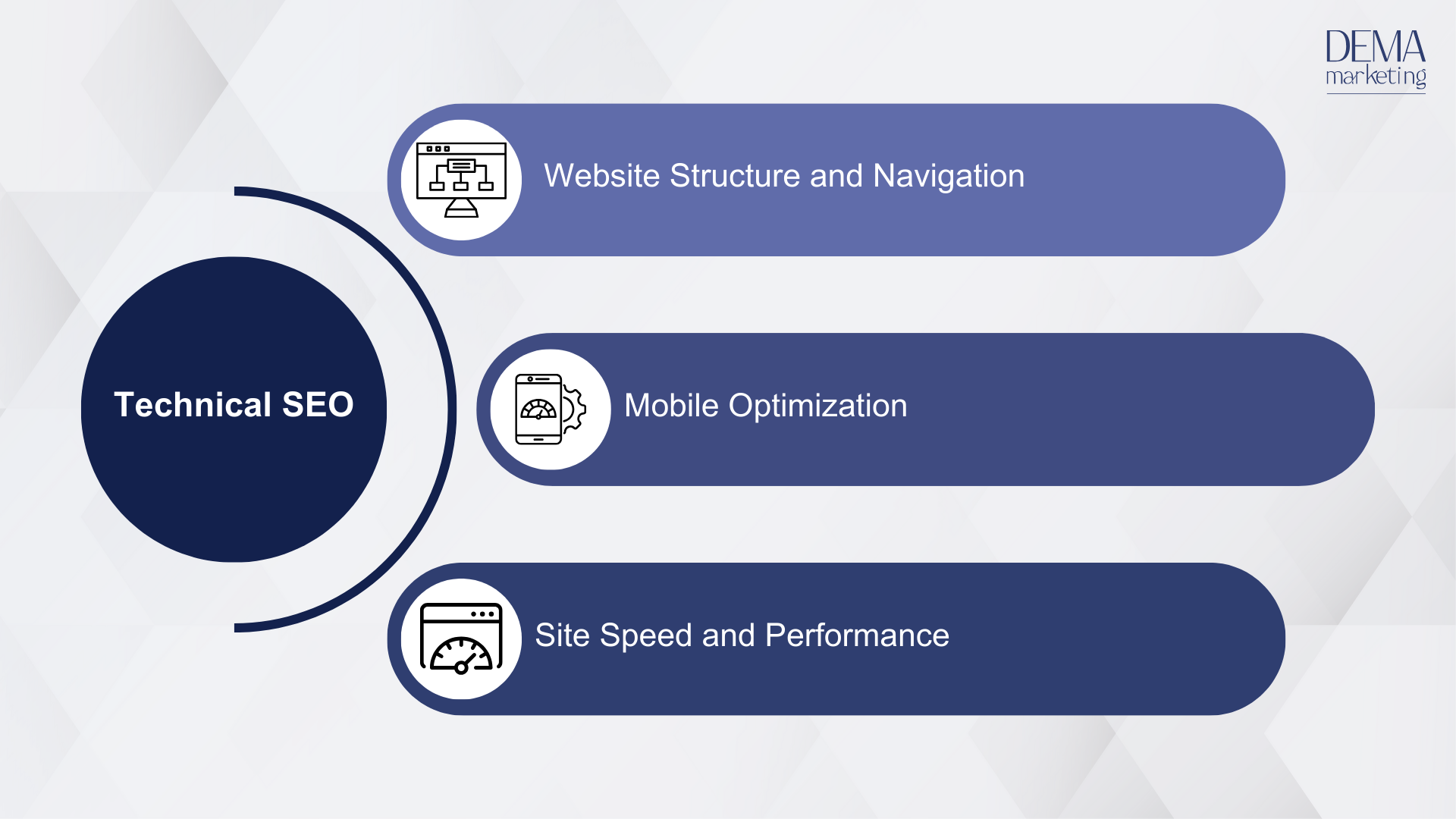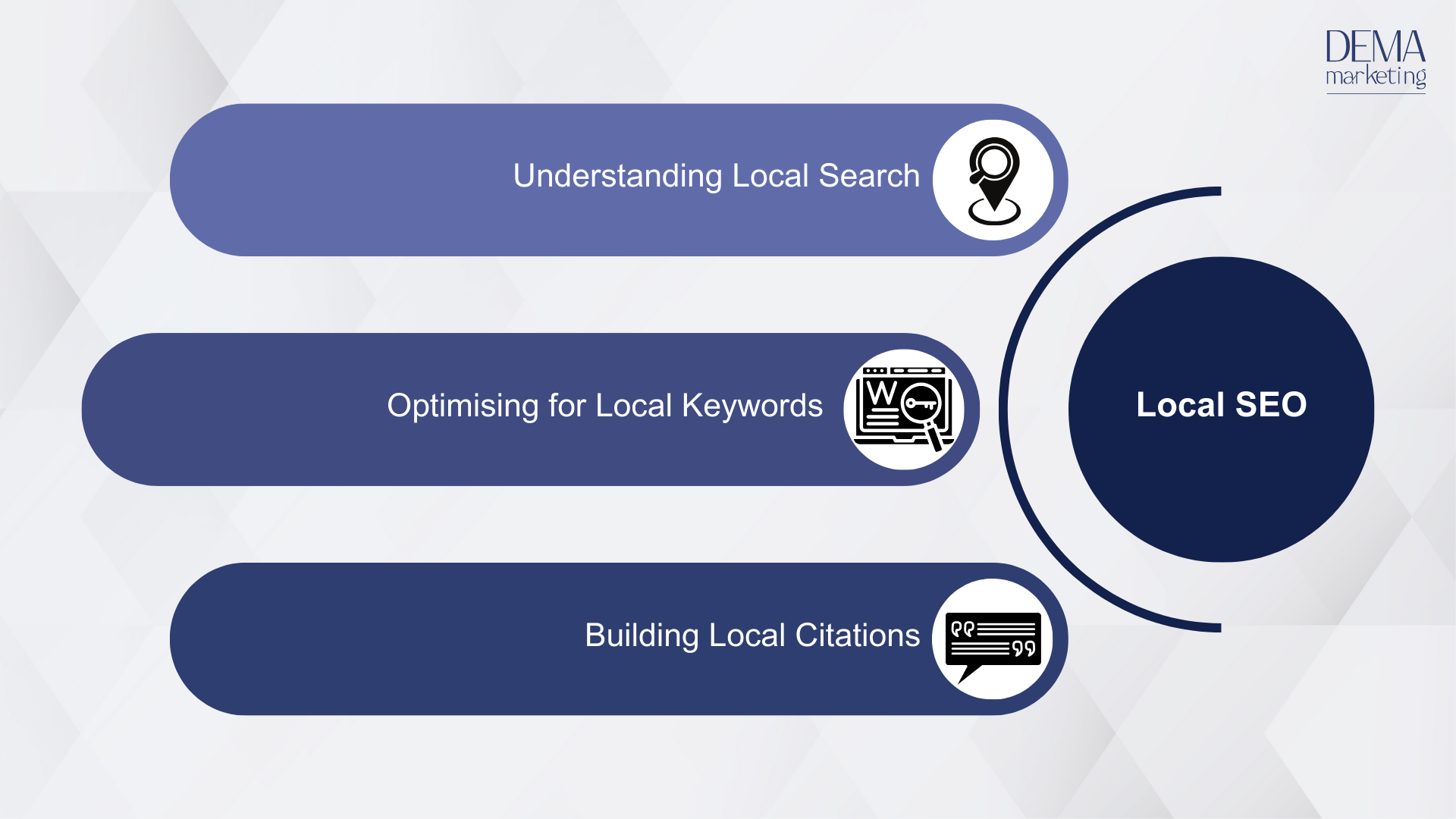Search Engine Optimization is a strategic process to enhance a website’s visibility in the organic search results of search engines like Google, Bing, and Yahoo. How does SEO work?
SEO involves various techniques and best practices to ensure that a website ranks higher for relevant keywords and phrases that potential customers are searching for. By optimising both the content and the technical aspects of a site, businesses can improve their chances of being discovered by their target audience.
The experts at DEMA Marketing bring you this comprehensive SEO guide split in two parts. In Part 1, we covered what search engines are, as well as key on and off-page components of SEO. In this part, we’ll discuss in more detail all the factors that play a role in website ranking. In addition, you will learn more about the tools used for SEO performance analysis, advanced tactics and methods for boosting search ranking positions.
Why Is Understanding SEO Important?

Neglecting the importance of SEO is a disinformation error that one can make. With most online experiences beginning with a search engine, securing a prominent position in search results is crucial for attracting traffic, generating leads, and ultimately driving sales. High rankings not only increase the visibility of a business but also enhance its credibility and trustworthiness in the eyes of consumers.
Moreover, SEO provides a cost-effective marketing strategy that yields long-term benefits, making it an essential component of any digital marketing plan. By continuously adapting to the evolving algorithms of search engines, businesses can stay ahead of the competition and ensure sustained growth and success online.
How Does SEO Work?

SEO enhances various aspects of a website to improve its visibility in search engine results. This involves a combination of strategies and techniques designed to make a website more appealing to search engines and users. The key components of SEO include on-page and off-page optimization, technical SEO, local SEO, and continuous measurement and adjustment of strategies. Here’s a closer look at how these elements improve a website’s search engine ranking.
- On-Page and Off-Page Optimization: SEO involves on-page and off-page optimization. On-page optimization includes improving elements within your website, while off-page optimization focuses on building your website’s authority and reputation through activities outside your website.
- Technical SEO and Local SEO: Technical SEO involves optimising your website for search engines, while local SEO focuses on improving your online presence to attract more local business.
- SEO Measurement and Strategies: Effective SEO requires continuous measurement, strategy adjustment, and tracking of user behaviour with tools like Google Analytics. Keeping abreast of changes in search engine algorithms and industry trends and monitoring competitor strategies is essential for maintaining and improving search engine rankings.
On-Page SEO
Advancing on-page SEO enhances specific web pages to boost their search engine rankings and draw in more organic traffic. It encompasses a variety of elements that can be directly managed and controlled within the website. Effective on-page SEO not only enhances a site’s visibility but also provides a better user experience, ultimately driving higher engagement and conversions.
Optimising Content
Content is the cornerstone of on-page SEO. High-quality, relevant content that meets the needs and expectations of your audience is essential. This involves creating informative, engaging, and valuable content that addresses users’ search intent. Regularly updating your content ensures it remains current and useful. Additionally, organising content with clear headings and subheadings helps search engines understand your page’s structure and main points, making it easier to index and rank.
Using Keywords Effectively
Keywords are the foundation of SEO. People enter these words and phrases into search engines when searching for information. Effective keyword use involves thorough keyword research to identify the terms your target audience is searching for. Once identified, you should naturally integrate these keywords into your content, including titles, headings, meta descriptions, and body text. Avoid excessive keyword usage, as it can result in penalties from search engines. Instead, focus on using keywords to improve the readability and value of your content.
Improving User Experience
User experience (UX) is a critical aspect of on-page SEO. A well-designed website with a clean, intuitive layout makes it easier for users to find the necessary information. This includes fast loading times, a critical factor for user satisfaction and search engine ranking. Make sure your website is compatible with mobile devices, as a large portion of internet traffic originates from mobile devices. Use multimedia elements like images and videos to break up text and make your content more engaging. You should optimise these elements for quick loading and relevance to the content.
Off-Page SEO
Off-page SEO refers to all the activities conducted outside the boundaries of your website that influence your search engine rankings. Unlike on-page SEO, which focuses on optimising elements within your site, off-page SEO aims to increase your website’s authority and credibility through external means. This involves various strategies that contribute to improving your site’s reputation and trustworthiness in the eyes of search engines and users alike.
Importance of Backlinks
Backlinks, or inbound links from other websites to your own, are among the most significant factors in off-page SEO. They act as endorsements from other websites, signalling to search engines that your content is valuable and authoritative. High-quality backlinks from reputable sources can greatly enhance your site’s credibility and rankings. However, not all backlinks are created equal; links from authoritative and relevant sites are far more valuable than those from low-quality or unrelated sites. Building a robust backlink profile involves creating high-quality content that others want to link to and engaging in outreach efforts to secure links from reputable sites.
Social Media and SEO
While social media signals are not directly ranking factors, they are essential in off-page SEO. Sharing your content on social media increases its visibility and the likelihood of earning backlinks. Active engagement on social media can drive traffic to your website, enhance brand awareness, and create opportunities for link-building. Social media profiles often rank in search engine results, contributing to your overall online presence. You can amplify your content’s reach and impact by integrating your SEO and social media strategies.
Building Domain Authority
Domain authority measures your website’s overall strength and credibility in its niche. Various factors, including the quality and quantity of backlinks, the relevance of your content, and your site’s overall performance, determine your website authority. Increasing your domain authority involves consistently producing high-quality content that earns backlinks, maintaining a solid social media presence, and ensuring your site is technically sound. Useful information sources like Moz and Ahrefs provide metrics for tracking and improving your domain authority. A higher domain authority generally correlates with better search engine rankings and increased trust from users and search engines.
Technical SEO

Technical SEO involves optimising a website’s backend structure and foundation to improve its visibility and ranking in search engine results. Unlike on-page and off-page SEO, which focus on content and external signals, technical SEO ensures that search engines can efficiently crawl, index, and understand your site. This aspect of SEO is crucial for providing a solid framework that supports all other SEO efforts.
Website Structure and Navigation
A well-organized website structure is essential for both user experience and search engine optimization. A clear, logical hierarchy of pages makes it easier for visitors to find the information they need and for search engines to crawl and index your site. Key elements include:
- Clean URL Structure: Use descriptive, keyword-rich URLs that indicate the content of each page.
- Internal Linking: Implement a robust internal linking strategy to help search engines understand the relationships between different pages on your site and distribute link equity.
- Sitemaps: Generate and send XML sitemaps to search engines to find and include all crucial pages in the index.
- Breadcrumbs: Use breadcrumb navigation to enhance user experience and provide additional context to search engines.
Mobile Optimization
With the increasing use of mobile devices for internet browsing, mobile optimization is a critical component of technical SEO. Google’s mobile-first indexing means that the mobile version of your site is considered the primary version for ranking purposes. Necessary considerations for mobile optimization include:
- Responsive Design: Ensure your website automatically adjusts to different screen sizes and provides a seamless experience across all devices.
- Mobile-Friendly Content: Optimise content for mobile users using shorter paragraphs, larger fonts, and touch-friendly buttons.
- Accelerated Mobile Pages (AMP): Consider applying AMP to improve loading times and performance on mobile devices, providing a faster and smoother user experience.
Site Speed and Performance
Site speed is a significant ranking factor affecting user experience and search engine rankings. A website that loads slowly can result in more visitors leaving without interacting and a reduced likelihood of users taking desired actions. To enhance site speed and performance, consider the following:
- Optimise Images: Compress images to reduce file size without compromising quality and use appropriate formats (e.g., WebP) for faster loading.
- Minify Code: Remove unnecessary characters, comments, and spaces to reduce the size of HTML, CSS, and JavaScript files.
- Leverage Browser Caching: Enable browser caching to store static resources on users’ devices, reducing the need to reload them on subsequent visits.
- Use a Content Delivery Network (CDN): Distribute your site’s content across multiple servers worldwide to ensure faster delivery to users regardless of location.
Local SEO

Local SEO is a specific area of search engine optimization that concentrates on fine-tuning a website to appear in local search results. It is particularly crucial for businesses that operate in specific geographic regions or have physical locations, such as retail stores, restaurants, or service providers. Effective local SEO can help attract more local customers and drive foot traffic to your business.
Understanding Local Search
Local search refers to the process users go through when seeking products, services, or businesses within a specific geographic area. These searches often include location-based keywords or are conducted using location-based search features. For example, a user might search for “coffee shops near me” or “best engineer in London.” Local searches typically yield results that include local businesses, Google Maps listings, and other location-specific content. Understanding how local search works is the first step to optimising for it.
Optimising for Local Keywords
Local keyword optimization involves incorporating location-specific terms into your website content and metadata. Here’s how to effectively optimise for local keywords:
- Keyword Research: Use tools like Google Keyword Planner, Ahrefs, or Semrush to identify popular local search terms relevant to your business. Focus on keywords that include your city, neighbourhood, or region, such as “Manchester bakery” or “engineer in London.”
- Content Integration: Naturally incorporate these local keywords into your website’s content, including titles, headings, meta descriptions, and body text. Ensure the content is relevant and valuable to your local audience.
- Geo-Targeted Landing Pages: Create dedicated landing pages for each location you serve. These pages should include local keywords and provide specific information about your services in that area.
Building Local Citations
Local keyword optimization involves incorporating location-specific terms into your website content and metadata. Here’s how to effectively optimise for local keywords:
- Keyword Research: Use tools like Google Keyword Planner, Ahrefs, or SEMrush to identify popular local search terms relevant to your business. Focus on keywords that include your city, neighbourhood, or region, such as “Manchester bakery” or “engineer in London.”
- Content Integration: Naturally incorporate these local keywords into your website’s content, including titles, headings, meta descriptions, and body text. Ensure the content is relevant and valuable to your local audience.
- Geo-Targeted Landing Pages: Create dedicated landing pages for each location you serve. These pages should include local keywords and provide specific information about your services in that area.
Measuring SEO Success

Measuring the success of your SEO efforts is required to understand what strategies are working, what needs improvement, and how to continually optimise your website for better performance. You can make informed, data-driven decisions that drive long-term success by tracking the right metrics and using the right tools.
Key Performance Indicators
Key performance indicators (KPIs) are the metrics that help you evaluate the effectiveness of your SEO strategies. Here are some essential KPIs to monitor:
- Organic Traffic: The number of visitors who visit your site through organic search results. This is a direct indicator of your SEO performance.
- Keyword Rankings: The positions your website holds in search engine results pages (SERPs) for targeted keywords. Higher rankings typically lead to more traffic.
- Bounce Rate: The percentage of individuals who exit your website after looking at a single page. A high bounce rate may indicate your content could be more engaging and relevant to visitors.
- Click-Through Rate (CTR): The percentage of people who click on your site’s link in the search results. A higher CTR indicates that your title tags and meta descriptions are effective.
- Conversion Rate: The percentage of visitors who complete a desired action, such as purchasing or filling out a contact form. This shows how well your site is turning visitors into customers.
- Backlink Profile: The quantity and quality of backlinks directing to your site. A strong backlink profile can enhance your site’s authority and ranking potential.
Tools for Tracking SEO Performance
Several tools can help you track and analyse your SEO performance, providing valuable insights and data:
- Google Analytics: A powerful tool that tracks organic traffic, bounce rate, and conversion rate metrics. It offers detailed reports on user behaviour and site performance.
- Google Search Console: Provides insights into your site’s search traffic and performance, including keyword rankings, CTR, and indexing issues. It also helps you identify and fix technical SEO problems.
- Ahrefs: A comprehensive SEO tool that offers keyword tracking, backlink analysis, and competitor research. It provides detailed reports on your site’s SEO health and performance.
- Semrush: An all-in-one marketing toolkit that tracks keyword rankings and backlinks and provides competitive analysis. It also offers site audit features to identify technical issues.
- Moz Pro: Offers keyword tracking, site audits, and backlink analysis. It also provides actionable recommendations to improve your site’s SEO performance.
Making Data-Driven Decisions
Data-driven decision-making involves using the insights from tracking your KPIs and SEO tools to refine and optimise your strategies. Here’s how to leverage data for better SEO outcomes:
- Identify Trends and Patterns: Regularly review your SEO data to identify trends and patterns. For example, if you notice a decline in organic traffic, investigate potential causes such as technical issues, changes in search algorithms, or increased competition.
- Set Realistic Goals: Use your data to set achievable SEO goals. For example, aim to increase organic traffic by a certain percentage over a specific period or improve keyword rankings for targeted terms.
- Test and Optimise: Continuously test different SEO strategies and tactics. For instance, experiment with different types of content, keyword placements, or backlink strategies to see what works best.
- Focus on User Experience: Data on user behaviour, such as bounce rate and time on page, can provide insights into how users interact with your site. Use this information to improve the user experience by enhancing site design, content, and navigation.
- Monitor Competitors: Use SEO tools to analyse your competitors’ performance. Understanding their strategies can help you identify opportunities and gaps in your approach.
Advanced SEO Strategies
As search engine algorithms and user behaviours evolve, staying ahead of the curve with advanced SEO strategies becomes crucial. These strategies go beyond the basics to help you capture more organic traffic and improve your website’s visibility. Key focus areas include voice search optimization, featured snippets and structured data, and international SEO considerations.
Voice Search Optimization
Voice search is rapidly gaining popularity, driven by the increasing use of smart speakers and virtual assistants like Siri, Alexa, and Google Assistant. Optimising for voice search involves several unique considerations:
- Natural Language Keywords: Voice searches tend to be more conversational and question-based. Optimise your content for natural language queries by incorporating long-tail keywords and phrases that mimic how people speak. For example, instead of targeting “best restaurants London,” you might use “What are the best restaurants in London?”
- Answering Questions: Many voice searches are questions. Structuring your content to provide clear, concise answers can improve your chances of being featured in voice search results. Use FAQs, how-to guides, and direct answers to common questions within your content.
- Local Optimization: Voice searches frequently have local intent, including queries like “near me.” To better your business for local SEO, claim and update your Google My Business profile and include location-specific keywords in your content.
Featured Snippets and Structured Data
For businesses targeting a global audience, international SEO involves advancing your website to rank in multiple countries and languages. This requires careful planning and execution to ensure your content is relevant and accessible to users worldwide.
- Hreflang Tags: Use hreflang tags to indicate a webpage’s language and geographic targeting. This helps search engines serve the correct version of your site to users based on their language and location. Implement hreflang tags correctly to avoid duplicate content issues and improve user experience.
- Localised Content: Create content tailored to your target markets’ cultural and linguistic preferences. This includes translating content accurately and considering local customs, values, and search manners. Use native speakers or professional translation services to ensure quality.
- International Keyword Research: Conduct keyword research specific to each target market. Keywords that perform well in one country may need to be more effective in another. Tools like Google Keyword Planner and Ahrefs can help identify relevant keywords for different regions.
- Technical Considerations: Ensure your website is technically optimised for international SEO. This includes fast loading time, mobile responsiveness, and secure connections (HTTPS) across all versions of your site. Additionally, consider using country-specific domains (ccTLDs) or subdirectories to target international audiences better.
White Hat SEO vs. Black Hat SEO
The techniques utilised to improve a website’s position in search engine results fall into two main categories: White Hat and Black Hat SEO. It’s crucial to grasp the differences between these approaches to ensure a sustainable and ethical SEO strategy that attracts website visitors and complies with search engine standards.
| Feature | White Hat SEO | Black Hat SEO |
| Definition | White Hat SEO involves optimization strategies, techniques, and tactics that focus on a human audience and adhere to search engine rules and policies. | Black Hat SEO involves aggressive and often unethical strategies that attempt to manipulate search engine algorithms to achieve higher rankings. |
| Purpose of use | It aims to improve search engine rankings through high-quality content, ethical link-building practices, and overall website optimization that enhances user experience. | It aims to gain quick and substantial improvements in a website’s visibility and traffic by exploiting weaknesses in search engine algorithms. |
| Content Quality | The content quality is excellent, relevant, and original. | The content quality is often bad, irrelevant, or duplicated. |
| Keyword Usage | The keyword usage is strategic and the focus keyphrase is evenly spread. | The keyword usage is unstrategic and stuffed, and the focus keyphrase is unevenly spread. |
| Link Building | The Link Building is based on legitimate means such as guest posting, partnerships, and producing shareable content. | The Link Building is based on methods like link farms and paid links. |
| User Experience | It bases link-building on legitimate means such as guest posting, partnerships, and producing shareable content. | It bases link-building on methods like link farms and paid links. |
| Reputation | It builds trust and credibility with users and search engines. | It damages trust and credibility; can harm reputation. |
| Examples |
|
|
Conclusion
Having answered the question “How does SEO work?” we touched upon industry-approved tools used for performance and analytics. We explored on-page and off-page SEO, technical SEO, local SEO, and advanced optimization strategies. We also discussed and compared White Hat and Black Hat SEO practices.
What does the future hold for SEO? With advancements in artificial intelligence and machine learning, search engines are becoming more sophisticated in understanding user intent and delivering highly relevant results.
Voice search is expected to grow, making natural language processing a crucial component of SEO. Mobile-first indexing and the importance of mobile optimization will continue to dominate as more users access the internet via mobile devices. Structured data and rich snippets will become even more significant, helping websites stand out in the increasingly competitive SERPs.
Additionally, as global internet usage expands, international SEO will become vital for businesses aiming to reach diverse markets. The emphasis on user experience, fast-loading sites, and secure connections (HTTPS) will remain critical ranking factors.
Wait no longer and miss not a single business opportunity – optimise your site now and secure your spot at the top of the SERPs! Start applying these proven techniques today and see immediate improvements in your website’s search engine rankings. For personalised assistance and advanced SEO services, fill out our contact form and let our experts help you achieve your digital marketing goals.



